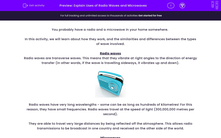You probably have a radio and a microwave in your home somewhere.
In this activity, we will learn about how they work, and the similarities and differences between the types of wave involved.
Radio waves
Radio waves are transverse waves. This means that they vibrate at right angles to the direction of energy transfer (in other words, if the wave is travelling sideways, it vibrates up and down).

Radio waves have very long wavelengths - some can be as long as hundreds of kilometres! For this reason, they have small frequencies. Radio waves travel at the speed of light (300,000,000 metres per second).
They are able to travel very large distances by being reflected off the atmosphere. This allows radio transmissions to be broadcast in one country and received on the other side of the world.
Microwaves
Microwaves have a few things in common with radio waves: they are transverse, they travel at the speed of light, and of course, they transfer energy.
However, there are some differences in their properties. The wavelengths of microwaves are smaller than radio waves - they only range from about 1 mm to 30 cm. They therefore have a higher frequency than radio waves. Furthermore, microwaves have more energy than radio waves.

You will be most familiar with microwaves being used to cook food. Microwaves do this by forcing the molecules in food to vibrate faster, raising the food's temperature. In doing so, the waves transfer their energy to heat energy.
However, microwaves can do so much more than cooking! Their original use was actually for radar signals to detect boats and aeroplanes. The idea of using microwaves to cook food only happened in the 1940s when an engineer with a chocolate bar in his pocket stood next to a microwave transmitter and realised the chocolate had melted. The discovery was entirely accidental!

Today, microwaves are used in communications, but unlike radio waves, microwaves cannot reflect off the atmosphere. So, in order for microwaves to be transmitted over large distances, they are sent to satellites. Your mobile phone's calls, texts, and data all use microwaves.
Let's find out more by tackling the questions.








